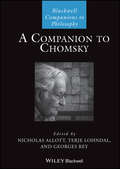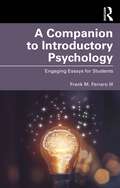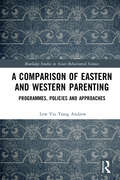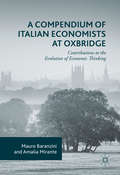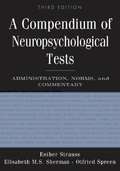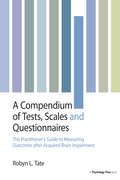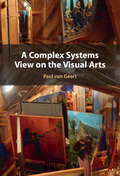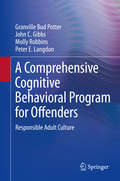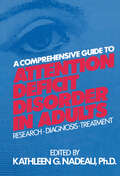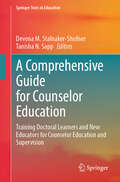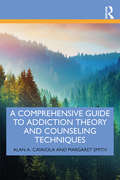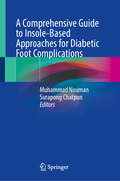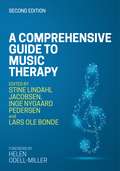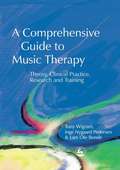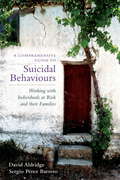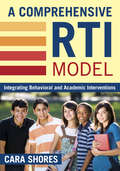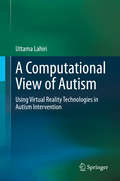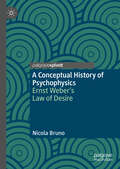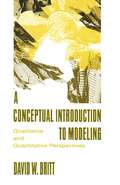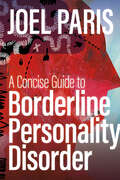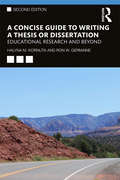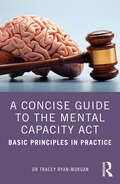- Table View
- List View
A Companion to Chomsky (Blackwell Companions to Philosophy)
by Rey Allott Lohndal, Rey Allott LohndalA COMPANION TO CHOMSKY Widely considered to be one of the most important public intellectuals of our time, Noam Chomsky has revolutionized modern linguistics. His thought has had a profound impact upon the philosophy of language, mind, and science, as well as the interdisciplinary field of cognitive science which his work helped to establish. Now, in this new Companion dedicated to his substantial body of work and the range of its influence, an international assembly of prominent linguists, philosophers, and cognitive scientists reflect upon the interdisciplinary reach of Chomsky’s intellectual contributions.Balancing theoretical rigor with accessibility to the non-specialist, the Companion is organized into eight sections—including the historical development of Chomsky’s theories and the current state of the art, comparison with rival usage-based approaches, and the relation of his generative approach to work on linguistic processing, acquisition, semantics, pragmatics, and philosophy of language. Later chapters address Chomsky’s rationalist critique of behaviorism and related empiricist approaches to psychology, as well as his insistence upon a “Galilean” methodology in cognitive science. Following a brief discussion of the relation of his work in linguistics to his work on political issues, the book concludes with an essay written by Chomsky himself, reflecting on the history and character of his work in his own words.A significant contribution to the study of Chomsky’s thought, A Companion to Chomsky is an indispensable resource for philosophers, linguists, psychologists, advanced undergraduate and graduate students, and general readers with interest in Noam Chomsky’s intellectual legacy as one of the great thinkers of the twentieth century.
A Companion to Introductory Psychology: Engaging Essays for Students
by Frank M. Ferraro IIIA Companion to Introductory Psychology is a rich collection of thought-provoking chapters, which enhance student interest and promote group discussions, training entry-level students in critical thinking skills and engaging them with course material.Organized into five key sections—Biological, Cognition, Developmental, Social and Personality, and Mental and Physical Health—each features contemporary chapters accompanied by insightful discussion questions, further resources, and activities to encourage reflection by the reader and to promote group debate in a classroom context. These prompt readers to reflect deeply, to evaluate long-held beliefs and/or personal biases, and to assess controversial topics by analyzing them through a psychological lens.Mapped to the American Psychological Association Pillar model, this book will benefit a wide variety of audiences ranging from high school to college undergraduates. Primarily useful for courses in introductory psychology, this book is also practical for courses in behavioral neuroscience, cognitive psychology, developmental psychology, social psychology, health psychology, and abnormal and clinical psychology.
A Comparison of Eastern and Western Parenting: Programmes, Policies and Approaches (Routledge Studies in Asian Behavioural Sciences)
by Low Yiu Tsang AndrewParenting adolescents is a challenging task for parents. Professionals offer a range of support and parenting programmes to support parents. However, the importance of culturally adapting parenting programmes to benefit parents and their adolescent children hasn’t always been understood. This book provides a comparison of East and West parenting approaches and parenting programmes to show how vital a culturally sensitive approach is to the positive development of the parent-adolescent relationship. It offers a comprehensive overview of current theories and research on parenting adolescents. It focuses on comparing the differences in parenting style and practice between Chinese parents and their Western counterparts and the policy context in Chinese culture with that in the West. It also offers guidance on how to conduct an evaluation of parenting programmes and how to adapt them for the right cultural setting. Postgraduate students studying parenting, developmental psychology or social work will find this work particularly useful, as will researchers in any of these areas.
A Compendium of Italian Economists at Oxbridge: Contributions to the Evolution of Economic Thinking
by Mauro Baranzini Amalia MiranteThisstudy examines five decades of Italian economists who studied or researched atthe Universities of Oxford and Cambridge between the years 1950 and 2000. Providing a detailed list of Italian economists associated with Hicks, Harrod,Bacharach, Flemming, Mirrlees, Sen and other distinguished dons, the authorsexamine eleven research lines, including the Sraffa and the neo-Ricardianschool, the post-Keynesian school and the Stone's and Goodwin's schools. Baranzini and Mirante trace the influence of the schools in terms of 1) theirfundamental role in the evolution of economic thought; 2) their promotion offour key controversies (on the measurement of technical progress, on capitaltheory, on income distribution and on the inter-generational transmission ofwealth); 3) the counter-flow of Oxbridge scholars to academia in Italy, and 4)the invigoration of a third generation of Italian economists researching orteaching at Oxbridge today. A must-read for all those interested in the way Italian and British research has shaped the study and teaching of economics.
A Compendium of Neuropsychological Tests: Administration, Norms, and Commentary
by Esther Strauss Elisabeth M. S. Sherman Otfried SpreenFor the practicing neuropsychologist or researcher, keeping up with the sheer number of newly published or updated tests is a challenge, as is evaluating the utility and psychometric properties of neuropsychological tests in a clinical context. The goal of the third edition of A Compendium of Neuropsychological Tests, a well-established neuropsychology reference text, is twofold. First, the Compendium is intended to serve as a guidebook that provides a comprehensive overview of the essential aspects of neuropsychological assessment practice. Second, it is intended as a comprehensive sourcebook of critical reviews of major neuropsychological assessment tools for the use by practicing clinicians and researchers. Written in a comprehensive, easy-to-read reference format, and based on exhaustive review of research literature in neuropsychology, neurology, psychology, and related disciplines, the book covers topics such as basic aspects of neuropsychological assessment as well as the theoretical background, norms, and the utility, reliability, and validity of neuropsychological tests. For this third edition, all chapters have been extensively revised and updated. The text has been considerably expanded to provide a comprehensive yet practical overview of the state of the field. Two new chapters have been added: "Psychometrics in Neuropsychological Assessment" and "Norms in Psychological Assessment. " The first two chapters present basic psychometric concepts and principles. Chapters three and four consider practical aspects of the history-taking interview and the assessment process itself. Chapter five provides guidelines on report-writing and chapters six through sixteen consist of detailed, critical reviews of neuropsychological tests, and address the topics of intelligence, achievement, executive function, attention, memory, language, visual perception, somatosensory olfactory function, mood/personality, and response bias. A unique feature is the inclusion of tables that summarize salient features of tests within each domain so that readers can easily compare measures. Additional tables within each test review summarize important features of each test, highlight aspects of each normative dataset, and provide an overview of psychometric properties. Of interest to neuropsychologists, neurologists, psychiatrists, and educational and clinical psychologists working with adults as well as pediatric populations, this volume will aid practitioners in selecting appropriate testing measures for their patients, and will provide them with the knowledge needed to make empirically supported interpretations of test results.
A Compendium of Tests, Scales and Questionnaires: The Practitioner's Guide to Measuring Outcomes after Acquired Brain Impairment
by Robyn L. TateThis Compendium is a comprehensive reference manual containing an extensive selection of instruments developed to measure signs and symptoms commonly encountered in neurological conditions, both progressive and non-progressive. It provides a repository of established instruments, as well as newly-developed scales, and covers all aspects of the functional consequences of acquired brain impairment.In particular, the text provides a detailed review of approximately 150 specialist instruments for the assessment of people with neurological conditions such as dementia, multiple sclerosis, stroke and traumatic brain injury. Part A presents scales examining body functions, including consciousness and orientation; general and specific cognitive functions; regulation of behaviour, thought, and emotion; and motor-sensory functions. Part B reviews scales of daily living activities and community participation. Part C focuses on contextual factors, specifically environmental issues, and Part D contains multidimensional and quality of life instruments.Each instrument is described in a stand-alone report using a uniform format. A brief history of the instrument's development is provided, along with a description of item content and administration/scoring procedures. Psychometric properties are reviewed and a critical commentary is provided. Key references are cited and in most cases the actual scale is included, giving the reader easy access to the instrument. The structure of the book directly maps onto the taxonomy of the influential International Classification of Functioning, Disability and Health (World Health Organization, 2001), enabling linkage of clinical concepts across health conditions.The Compendium will be a valuable reference for clinicians, researchers, educators, and graduate students, and a practical resource for those involved in the assessment of people with brain impairment. The book is accompanied by a password protected website. For a one-off payment, purchasers of the book can gain online access to the majority of the tests, scales and questionnaires featured in the book as downloadable PDFs. See inside the book for more details.
A Complex Systems View on the Visual Arts
by Paul van GeertThis book presents a comprehensive and unexpected approach to the visual arts, grounded in the theories of complexity and dynamical systems. Paul van Geert shows how complexity and dynamical systems theories, originally developed in mathematics and physics, offer a novel perspective through which to view the visual arts. Diverse aspects of visual arts as a practice, profession, and historical framework are covered. A key focus lies in the unique characteristics of complex systems: feedback loops bridging short- to long-term temporal scales, self-organizing into creative emergent properties; dynamics which may be applied to a wide range of topics. By synthesizing theory and empirical evidence from diverse fields including philosophy, psychology, sociology, art history, and economics, this pioneering work demonstrates the utility of simulation models in deciphering a surprisingly wide range of phenomena such as artistic (super)stardom and shifts within art historical paradigms.
A Comprehensive Cognitive Behavioral Program for Offenders: Responsible Adult Culture
by John C. Gibbs Granville Bud Potter Molly Robbins Peter E. LangdonThis book presents Responsible Adult Culture (RAC), a truly comprehensive program for helping offenders to think and act responsibly. It provides the tools of the program with great clarity. In addition to exploring the needs of all offenders, the book addresses the special needs of both female and dual-diagnosis offenders. Responsible thinking means habitually seeing others and situations accurately, rather than in self-serving and egocentrically distorted ways. Because self-centered thinking is typically reinforced by negative group norms, RAC starts with the cultivation of a constructive climate ("mutual help" groups) to motivate change. Motivated group members then gain tools for responsible thinking through "equipment" (cognitive behavioral) meetings. These tools pertain to social skills, anger management, and the correction of self-centered thinking through social perspective taking (cognitive restructuring). Beyond documented reductions in distorted thinking and recidivism rates, RAC's synergy or round-the-clock interpenetration of positive groups and tools promotes a safer and more humane institutional culture.
A Comprehensive Guide To Attention Deficit Disorder In Adults: Research, Diagnosis and Treatment
by Kathleen G. NadeauThis groundbreaking volume, written by pioneering clinicians and researchers firmly convinced of the neurobiological underpinnings of ADD in adults, is the first to provide broad coverage of this burgeoning field. Written for professionals who diagnose and treat adults with ADD, it provides information from psychologists and physicians on the most current research and treatment issues regarding our understanding of ADD as a neurobiological disorder. According to the contributors, ADD in adults may be responsible for difficulties ranging from minor attention, memory, and organization problems in well-functioning adults to drug abuse and criminal behavior. A Comprehensive Guide to Attention Deficit Disorder in Adults begins by addressing the history of ADD and the evolution of our understanding of the disorder. The neurobiology of ADD is examined, laying a solid foundation for the clinician to develop a scientific understanding of this complex syndrome. The assessment and differential diagnosis of ADD is explored from the perspectives of a variety of specialists in the field. This includes an exploration of the interrelationships between attention deficit disorder and other neurodevelopmental disabilities that may interact with ADD to affect cognitive functioning, and an examination of the connections between ADD and a host of psychiatric conditions. Also covered is the process of differential diagnosis from a neurological perspective, which will help the non-medically trained clinician better to determine when a complete neurological evaluation seems warranted in the assessment process. Authors examine ADD with and without hyperactivity and describe a wide range of assessment tools that can be useful in developing a full diagnostic picture of different conditions that must be addressed in treating adults with the disorder. A wealth of experience, highly practical suggestions, and an optimistic outlook are the hallmark of the section on treatment. The authors strongly recommend a multifaceted treatment plan combining medication, psychotherapy, and addressing the pervasive self-esteem issues which typically haunt the adult whose condition has gone untreated. Specific treatment issues for Adults with ADD are also discussed. These include:- * the development of practical life management skills * the difficulties in relationships * ADD within the context of marriage and family * and higher education and the workplace. The volume concludes with a discussion of the legal implications of the diagnosis of ADD in adults as it pertains to education and employment, the important role of support groups for adults with ADD, and a thought-provoking examination of current and future research including the need for increased public recognition of ADD in adults. A Comprehensive Guide to Attention Deficit Disorder in Adults is a pioneering volume that will bring the most current information available to the attention of those able to help adult ADD sufferers...vocation and rehabilitation counselors, and numerous psychotherapists who recognize symptoms of depression and anxiety, but perhaps overlook the underlying attention deficit disorder. It will stimulate the interdisciplinary research that is the key to increasing knowledge and educate those who can truly make a difference.
A Comprehensive Guide for Counselor Education: Training Doctoral Learners and New Educators for Counselor Education and Supervision (Springer Texts in Education)
by Devona M. Stalnaker-Shofner Tanisha N. SappThis book prepares doctoral learners and new counselor educators to enter into the profession of counselor education and supervision. The work outlines the total experience of teaching in counselor education by providing a practical guide for navigating higher education using best practices grounded in research and based on the lived experiences of seasoned counselor educator contributors. Using case scenarios, points of reflection, as well as the professional and personal accounts of current educators, this book serves as a soup-to-nuts guide outlining current best practices in counselor education. Written from a social justice perspective with efforts to emphasize diversity, equity, inclusion, accessibility, and belonging, more than 70% of the textbook contributors identify as Black, Indigenous, or People of Color (BIPOC). Additionally, all contributors identify as female with varying sexual identities, physical body sizes, and abilities, thus disrupting the dominant narrative. The chapters range in scope and cover topics such as best practices and strategies for teaching praxis, curriculum development, and strategies to develop CACREP specialization programs based on the 2024 CACREP standards and extant research. The book also provides chapters addressing recommendations for navigating higher education such as finding and landing the job, the first year as a counselor educator, the promotion and tenure process, and concludes with a section on personal and professional development for new and experienced counselor educators. A bonus feature of this book is the inclusion of a technological component offering a companion website with a repository of activities, exercises, and resources.
A Comprehensive Guide to Addiction Theory and Counseling Techniques
by Margaret Smith Alan A. CavaiolaA blend of theory and counseling techniques, this comprehensive text provides readers with an overview of several major counseling theories and their application to substance use disorders and addiction counseling, along with related techniques and interventions. Chapters incorporate cutting edge evidenced-based research on neuroscience, psychological and sociocultural theories explaining the biopsychosocial influences of substance use disorders, and examine how substance use disorder risk factors can be utilized when assessing someone who may have a substance use disorder. The text additionally helps apply theory to practice, offering intervention techniques and using accessible case studies. Throughout the text, highlighted learning opportunities and key terms further help students to practice and apply the theories, interventions and techniques that the book discusses. Mental health professionals, undergraduate and graduate students alike will benefit from this deft mix of prominent theory, innovative research and accessible case studies.
A Comprehensive Guide to Insole-Based Approaches for Diabetic Foot Complications
by Muhammad Nouman Surapong ChatpunThis comprehensive book covers a wide range of topics, providing valuable insights and evidence-based information on insole-based approaches for managing diabetic foot complications. These include custom-made insoles, offloading insoles, and therapeutic footwear, with different materials, shapes, and designs, clinical evaluation and prescription, current research trends, and real-life case studies, emphasizing their impact on plantar pressure distribution and overall foot health. The insole design plays a crucial role in reducing plantar pressures and preventing ulcers. The book delves into design features such as metatarsal additions, rocker soles, and cushioning with the importance of comfort, durability, and pressure redistribution. Healthcare professionals need to assess patients&’ individual needs and prescribe appropriate insoles. The book provides guidelines for evaluating foot biomechanics, gait patterns, and pressure points. Case studies illustrate how customized insoles can improve patient outcomes and prevent complications. Additionally, the book discusses cutting-edge research on insole technologies, topics including smart insoles with sensor technology, pressure-sensing insoles, and wearable devices. The book provides practical examples to demonstrate how insole-based approaches impact patient care. These case studies showcase successful outcomes, patient adherence, and the role of customized insoles in preventing ulcers. The primary audience for the book is podiatrists, orthopedic surgeons, endocrinologists, primary care physicians, and other healthcare providers specializing in diabetes management.
A Comprehensive Guide to Music Therapy, 2nd Edition: Theory, Clinical Practice, Research and Training
by Helen Odell-Miller Inge Nygaard Pedersen Lars Ole Bonde Stine Lindahl JacobsenMusic therapy as an intervention in medical, educational and many other environments has a rich and diverse history of methods, approaches and models. Consolidating the many components of music therapy, this completely updated edition of A Comprehensive Guide to Music Therapy covers everything students, teachers and practitioners of music therapy need to know.Building upon the work of Tony Wigram and developments within the field of music therapy over the last 15 years, this second edition looks at the theoretical foundation of music therapy, selected models and interventions, how it can be applied in clinical practice, and the recent progress made in research and evidence-based practice. Giving a complete picture of the multifaceted world of music therapy, it is a must-have for music therapy students, teachers and practitioners.
A Comprehensive Guide to Music Therapy: Theory, Clinical Practice, Research and Training
by Tony Wigram Lars Ole BondeMusic therapists, as in medical and paramedical professions, have a rich diversity of approaches and methods, often developed with specific relevance to meet the needs of a certain client population. This book reflects the many components of such diversity, and is a thoroughly comprehensive guide to accessing and understanding the ideas, theory, research results and clinical outcomes that are the foundations of this field. Providing a detailed insight into the field of music therapy from an international perspective, this book enables the reader to see the complete picture of the multifaceted and fascinating world that is music therapy.
A Comprehensive Guide to Suicidal Behaviours: Working with Individuals at Risk and their Families
by David Aldridge Sergio PerezOver a million people commit suicide worldwide every year. Taking an interdisciplinary approach that looks at the person at risk, the family and personal relationships they have and the communities in which they are embedded, this book will help anyone working with suicidal individuals to prevent this major cause of death. Backed up by research and clinical expertise the book clarifies the facts about suicide and debunks the many unfounded myths surrounding the subject. It covers the classifications and manifestations of suicide, as well as the major risk factors, at-risk groups and warning signs. Advice on effective communication and a repertoire of strategies for distress management are offered, not only for supporting at-risk individuals and those who have survived a suicide attempt, but also families coping with bereavement. A final chapter explores the impact of the internet and the digital age on both the propagation and prevention of suicide. This book will be essential reading for anybody working with people at risk of suicide, including clinicians, therapists, psychologists, social and healthcare workers and volunteers working in suicide prevention.
A Comprehensive Guide to Suicidal Behaviours: Working with Individuals at Risk and their Families
by David Aldridge Sergio PerezOver a million people commit suicide worldwide every year. Taking an interdisciplinary approach that looks at the person at risk, the family and personal relationships they have and the communities in which they are embedded, this book will help anyone working with suicidal individuals to prevent this major cause of death.Backed up by research and clinical expertise the book clarifies the facts about suicide and debunks the many unfounded myths surrounding the subject. It covers the classifications and manifestations of suicide, as well as the major risk factors, at-risk groups and warning signs. Advice on effective communication and a repertoire of strategies for distress management are offered, not only for supporting at-risk individuals and those who have survived a suicide attempt, but also families coping with bereavement. A final chapter explores the impact of the internet and the digital age on both the propagation and prevention of suicide.This book will be essential reading for anybody working with people at risk of suicide, including clinicians, therapists, psychologists, social and healthcare workers and volunteers working in suicide prevention.
A Comprehensive RTI Model: Integrating Behavioral and Academic Interventions
by Cara F. ShoresFeaturing interactive exercises and user-friendly tools, this research-based guide helps educators leverage resources and build teams to improve student behavior and academic achievement schoolwide.
A Computational View of Autism: Using Virtual Reality Technologies in Autism Intervention
by Uttama LahiriThis book first explains autism, its prevalence, and some conventional intervention techniques, and it then describes how virtual reality technology can support autism intervention and skills training. The approaches and technologies covered include immersive virtual reality, augmented reality and mixed reality. The tasks covered include emotion recognition, affective computing, teaching communication skills, imparting literacy skills, training for imitation skills, and joint attention skills. Most of the chapters assume no prerequisite knowledge of autism or virtual reality, and they are supported throughout with detailed references for further investigation.While the author is an engineer by profession, with specialist knowledge in robotics and computer-based platforms, in this book she adopts a user perspective and cites many real-life examples from her own experience. The book is suitable for students of cognitive science, and researchers and practitioners engaged with designing and offering technological assistance for special needs training.
A Conceptual History of Psychology: Exploring the Tangled Web
by John D. GreenwoodIn the new edition of this original and penetrating book, John D. Greenwood provides an in-depth analysis of the subtle conceptual continuities and discontinuities that inform the history of psychology from the speculations of the Ancient Greeks to contemporary cognitive psychology. He also demonstrates the fashion in which different conceptions of human and animal psychology and behavior have become associated and disassociated over the centuries. Moving easily among psychology, history of science, physiology, and philosophy, Greenwood provides a critically challenging account of the development of psychology as a science. He relates the remarkable stories of the intellectual pioneers of modern psychology, while exploring the social and political milieu in which they operated, and dispels many of the myths of the history of psychology, based upon the best historical scholarship of recent decades. This is an impressive overview that will appeal to scholars and graduate students of the history of psychology.
A Conceptual History of Psychophysics: Ernst Weber’s Law of Desire
by Nicola BrunoThis book explores the concept of psychophysics and details the development of the ideas which made the mathematisation of desire possible. The experience of desire accompanies us all throughout life, but dealing with it as psychologists and scientists is far from easy. Psychophysics was conceived to help map, mathematically, these unknowable feelings of desire. As such, this book will help to provide an accessible account of psychophysics while telling the story of its creation, which was, in essence, the birth of scientific psychology and contemporary cognitive neuroscience, alongside many of the technologies which characterize the contemporary world. It is a strange and intriguing story, which begins with the German physiologist Ernst Heinrich Weber in the first half of the nineteenth century, and its story will help the reader gain fresh insight into how scientists came to be able to map and quantify complex and private emotional states.
A Conceptual Introduction To Modeling: Qualitative and Quantitative Perspectives
by David W. BrittWhen seeking to test specific hypotheses in large data sets, social and behavioral scientists often construct models. Although useful in such situations, many phenomena of interest do not occur in large samples and do not lend themselves to precise measurement. In addition, a focus on hypothesis testing can constrict the potential use of models as organizing devices for emerging patterns -- summaries of what we believe we know about the dynamics of situation. This book bridges the gap between "quantitative" and "qualitative" modelers to reconcile the need to impose rigor and to understand the influence of context. Although there are many different uses for models, there is also the realistic possibility of doing credible research without their use. A critical reexamination of the assumptions used in quantitatively-oriented models, however, suggests ways to increase their effectiveness as organizers of both quantitative and qualitative data. Students of methods in psychology, sociology, education, management, social work, and public health -- and their instructors -- are increasingly expected to become familiar with both quantitative and qualitative approaches. Unfortunately, they find few vehicles for communication regarding the implications of overlapping work between the two approaches. Using models as organizing devices for a better dialogue between assumptions and data might facilitate this communication process.
A Concise Guide to Borderline Personality Disorder
by Joel ParisA brief, practical guide to the most current research on and treatment for borderline personality disorder (BPD). Borderline personality disorder (BPD) is associated with severe emotion dysregulation, widespread impulsivity, and highly unstable interpersonal relationships. BPD patients often threaten suicide, make attempts, or suffer from chronic suicidal ideation. The disorder is difficult to diagnose because it is complex, straddles multiple domains and often appears alongside several comorbidities. For all these reasons it is exceedingly difficult to treat, and presents a major challenge for mental health providers. In this updated, practical and evidence-based guide, author Joel Paris uses the biopsychosocial model to contextualize and inform diagnosis and treatment for BPD. Chapters describe risk factors associated with BPD, the development of BPD across the lifespan, and how BPD can be managed in therapy. While dialectical behavior therapy (DBT), is the most often studied therapeutic approach with this population, common factors in all approaches can be utilized to help patients regulate emotions, reduce impulsivity, and improve their interpersonal skills. Common challenges such as the length, expense, and general accessibility of treatment are examined in detail, as is as the risk of suicidality.
A Concise Guide to Understanding Suicide
by Pedro Ruiz Stephen H. Koslow Pedro Ruiz Charles B. Nemeroff Stephen H. KoslowSuicide rates continue to increase globally. The volume of research in this field has also expanded rapidly. In A Concise Guide to Understanding Suicide, leading researchers and clinicians provide a concise review of recent literature, report solutions achieved and give practical guidance for patient care to aid understanding and help prevent suicide. Each chapter is highly focused to provide pertinent information covering all major aspects of the field, from epidemiology and theories of causation through to treatment and prevention. This text will educate practicing clinicians, (psychologist, psychiatrists, nurses, counselors, and emergency room personal) and other health care workers and researchers, as well as providing a pathway for undergraduate and graduate students interested in furthering their understanding of the complexities surrounding suicide. Further, the mental health professionals and those in the social sciences will be extremely interested in this monograph, as will the University community, armed forces and interested lay public.
A Concise Guide to Writing a Thesis or Dissertation: Educational Research and Beyond
by Halyna M. Kornuta Ron W. GermaineA Concise Guide to Writing a Thesis or Dissertation provides clear, succinct, and intentional guidelines about organizing and writing a thesis or dissertation. Part I provides an overview for writing a thesis or dissertation. It describes the big picture of planning and formatting a research study, from identifying a topic to focusing on writing quality. Part II describes the framework and substance of a research study. It models the pattern generally found in a formal, five-chapter research study. Each chapter of a thesis or dissertation has a specific purpose, and this book focuses on each in an easy-to-follow structure. Chapter One reviews the headings and contents expected in the introduction of a study. Chapter Two provides advice for writing a literature review. Chapter Three discusses what to include when describing the methodology. These first three chapters form the proposal section of a study. Two additional chapters present results (Chapter Four) and provide discussion and conclusions (Chapter Five). Appendices offer resources for instructors and students, including a rubric for evaluating writing, exercises to strengthen skills in APA format, sample purpose statements, a research planning organizer, and a guide for scholarly writing. The book is designed overall to be a practical guide and resource for students for their thesis or dissertation process.
A Concise Guide to the Mental Capacity Act: Basic Principles in Practice
by Dr Tracey Ryan-MorganThis book provides a clear introduction to the Mental Capacity Act (MCA, 2005), offering an easy reference guide to the complex issues enshrined within the Act to inform the everyday practice of those who need to perform within its parameters as part of their day-to-day work. Bringing together clinical neuropsychology expertise with legal commentary, the book introduces the main principles and presumptions of the MCA (2005) and describes the processes involved in the comprehensive assessment of what can, in practice, be complex issues. It provides learning summaries, flowcharts, checklists and web references for easy to access resources. The chapters also contain a broad range of illustrative case examples with considerable emphasis given to those areas of complexity that are not addressed in current guidance and which often prove contentious in everyday practice, such as how particular forms of brain injury can lead to hidden difficulties with decision-making which can be challenging to assess and evidence in practice. The book is essential reading for trainee nurses, doctors, paramedics, social workers, lawyers, psychologists and health and social care support workers, as well as experienced health and social care professionals such as ward managers and care and nursing home managers who face mental capacity issues in their day to day working role.
